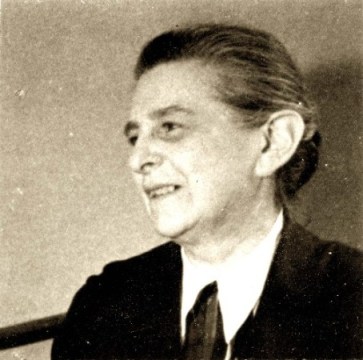Search for Names, Places and Biographies
Already layed Stumbling Stones
Suche
Katharina Behrend * 1872
Giesestraße 8 (Altona, Groß Flottbek)
1942 Theresienstadt
ermordet 8.8.1942
Käthe Ida Behrend, born on 18 Aug. 1872, deported on 15 July 1942 to Theresienstadt, date of death 7 Aug. 1942
Käthe Behrend was a mathematics teacher at the Bertha-Lyzeum, a girls’ high school, in Othmarschen, which was accommodated in a new building and renamed Gymnasium Hochrad in 1971. When she taught there, the Bertha-Lyzeum was housed in today’s community college (Volkshochschule) on Waitzstraße. One of her former students, Lisa von Buiren, vividly remembered Käthe Behrend in a commemorative volume of the Lyzeum dating from 1952:
"During a school hike on the Rissen Heath, Miss Behrend had settled to rest among our circle. We had just explained to her that for our part, we considered math superfluous; whereupon she tried to clarify to us the meaningfulness of math class; we in turn eagerly tried to convince her of the opposite. It was very amusing and charming how she went into the matter, grinning.”
In this commemorative publication, Käthe Behrend was officially remembered: "In calm modesty and with great kindness, she pursued her straight and reliable path of working and empathizing until in the year 1933 she quietly retired from school in grave contemporary circumstances and died already a few years later.” However, these nice words do not inform readers as to why Käthe Behrend’s path through life as a successful and popular qualified high school teacher with civil servant status was suddenly cut short and what really happened to her.
Katharina Henriette Ida Behrend was born in Chemnitz, the daughter of Gottlieb and Feodore Behrend, née Wolff. In 1904, she finished her university studies in mathematics, English, and French by completing the exam qualifying her for a secondary school teaching post. Since 1908, she worked as a high school teacher at the Bertha-Lyzeum. She was unmarried, lived in Othmarschen at Giesestraße 8, and was a member of the Protestant Church.
On 30 Sept. 1933, she was forcibly retired because of her Jewish descent. In accordance with the Law for the Restoration of the Professional Civil Service (Gesetz zur Wiederherstellung des Berufsbeamtentums) dated Apr. 1933, she was no longer permitted to work as a teacher at a non-Jewish school. The process of disenfranchisement and displacement of people with Jewish descent from public life had begun.
Like all persons of Jewish descent, Käthe Behrend had to disclose her assets and estimate her living expenses vis-à-vis the foreign currency office of the Chief Finance Administrator (Oberfinanzpräsident). She had a credit balance in an account with the Sparkasse amounting to 4,464 RM (reichsmark) and indicated that she required 385 RM a month, including 100 RM for rent. Obviously she was no longer able (or willing) to hold on to her apartment on Giesestraße. From 1939 onward, she lived at Krohnskamp 3, and in 1940, she moved to Grindelallee 23. In 1940, the National Socialist state put her assets under a "security order” (Sicherungsanordnung) and permitted her to dispose of only 300 RM a month. Extra expenses, such as 63 RM for a master painter, required a separate application to the Chief Finance Administrator. According to the files of the Chief Finance Administrator, on 16 June 1942, she was quartered in the nursing home of the Jewish Religious Community at Schäferkampsallee 29, one of the "Jews’ houses” ("Judenhäuser”) marked with a "Jews’ star” ("Judenstern”) and serving as collection points for the deportations.
On 15 July 1942, at the age of 70 years, Käthe Behrend was deported together with 926 other persons from Hamburg to Theresienstadt in what was then the "Protectorate of Bohemia and Moravia” ("Protektorat Böhmen und Mähren”). The deportation list of the Gestapo indicates her last residential address to be Sedanstraße 29. In the ghetto, she lived in building L 210, room 013. In this "ghetto for the elderly” for German Jews – as the Nazis misleadingly called it on occasion – malnutrition, damp accommodations, and lack of medical care resulted in a high mortality rate, especially among older people. Of the people on the first transport to Theresienstadt, 882 were determined to be fatalities. According to the death notice, Käthe Behrend was killed in Theresienstadt on 7 Aug. 1942, only a few weeks after her arrival. Supposedly she died of circulatory weakness due to pneumonia.
Translator: Erwin Fink
Kindly supported by the Hermann Reemtsma Stiftung, Hamburg.
© Birgit Gewehr
Quellen: 1; 2 (R 1940/202); 3 (Nr. 2303); 8; StaH 522-1 Jüdische Gemeinden, 992 e 1 Band 6 (Deportationsliste Theresienstadt 15.7.1942); Melanchthongemeinde, Ausstellung, darin: Festschrift des Bertha-Lyzeums zum 50-jährigen Bestehen, Hamburg 1952, Aussagen von Inge Hauffe, einer ehemaligen Schülerin von Käthe Behrend, Lehrerverzeichnis des Bertha-Lyzeums.


